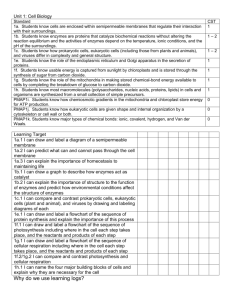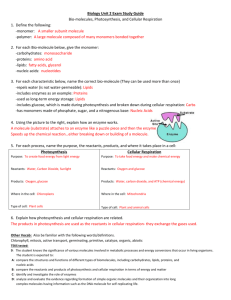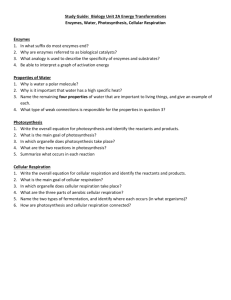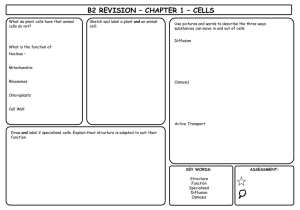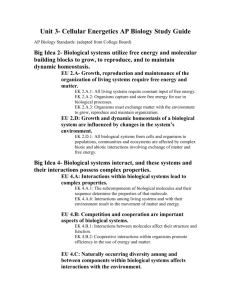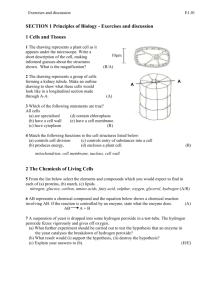9 Weeks Study Guide 12
advertisement
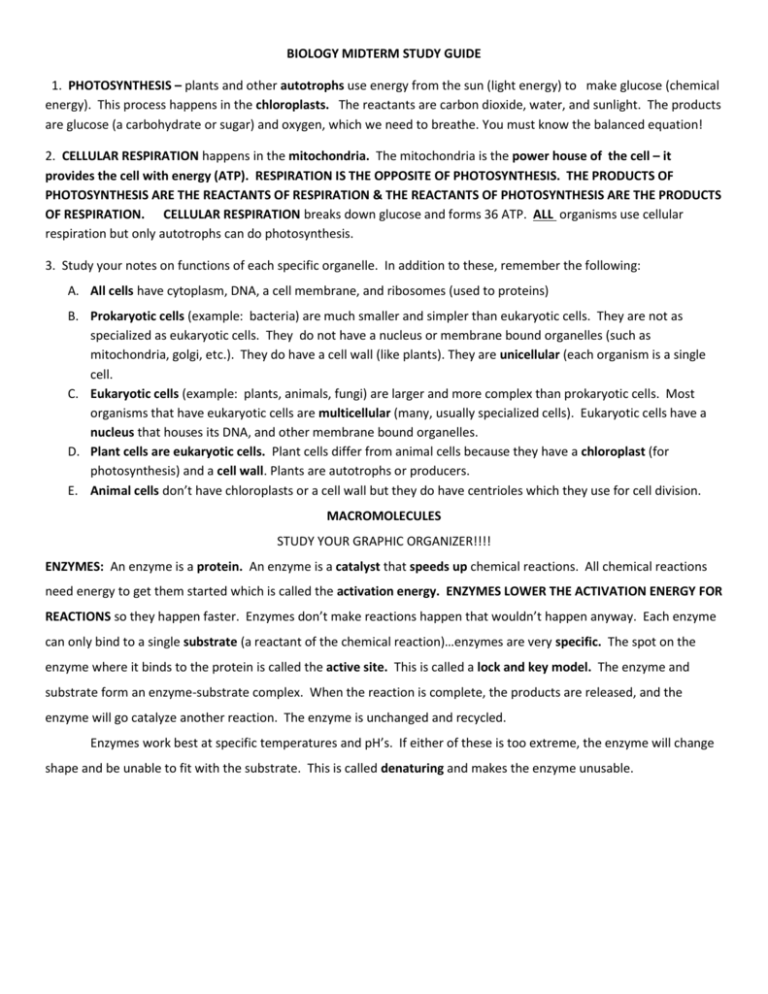
BIOLOGY MIDTERM STUDY GUIDE 1. PHOTOSYNTHESIS – plants and other autotrophs use energy from the sun (light energy) to make glucose (chemical energy). This process happens in the chloroplasts. The reactants are carbon dioxide, water, and sunlight. The products are glucose (a carbohydrate or sugar) and oxygen, which we need to breathe. You must know the balanced equation! 2. CELLULAR RESPIRATION happens in the mitochondria. The mitochondria is the power house of the cell – it provides the cell with energy (ATP). RESPIRATION IS THE OPPOSITE OF PHOTOSYNTHESIS. THE PRODUCTS OF PHOTOSYNTHESIS ARE THE REACTANTS OF RESPIRATION & THE REACTANTS OF PHOTOSYNTHESIS ARE THE PRODUCTS OF RESPIRATION. CELLULAR RESPIRATION breaks down glucose and forms 36 ATP. ALL organisms use cellular respiration but only autotrophs can do photosynthesis. 3. Study your notes on functions of each specific organelle. In addition to these, remember the following: A. All cells have cytoplasm, DNA, a cell membrane, and ribosomes (used to proteins) B. Prokaryotic cells (example: bacteria) are much smaller and simpler than eukaryotic cells. They are not as specialized as eukaryotic cells. They do not have a nucleus or membrane bound organelles (such as mitochondria, golgi, etc.). They do have a cell wall (like plants). They are unicellular (each organism is a single cell. C. Eukaryotic cells (example: plants, animals, fungi) are larger and more complex than prokaryotic cells. Most organisms that have eukaryotic cells are multicellular (many, usually specialized cells). Eukaryotic cells have a nucleus that houses its DNA, and other membrane bound organelles. D. Plant cells are eukaryotic cells. Plant cells differ from animal cells because they have a chloroplast (for photosynthesis) and a cell wall. Plants are autotrophs or producers. E. Animal cells don’t have chloroplasts or a cell wall but they do have centrioles which they use for cell division. MACROMOLECULES STUDY YOUR GRAPHIC ORGANIZER!!!! ENZYMES: An enzyme is a protein. An enzyme is a catalyst that speeds up chemical reactions. All chemical reactions need energy to get them started which is called the activation energy. ENZYMES LOWER THE ACTIVATION ENERGY FOR REACTIONS so they happen faster. Enzymes don’t make reactions happen that wouldn’t happen anyway. Each enzyme can only bind to a single substrate (a reactant of the chemical reaction)…enzymes are very specific. The spot on the enzyme where it binds to the protein is called the active site. This is called a lock and key model. The enzyme and substrate form an enzyme-substrate complex. When the reaction is complete, the products are released, and the enzyme will go catalyze another reaction. The enzyme is unchanged and recycled. Enzymes work best at specific temperatures and pH’s. If either of these is too extreme, the enzyme will change shape and be unable to fit with the substrate. This is called denaturing and makes the enzyme unusable. CELLULAR TRANSPORT – Study your vocabulary sheets & notes! SOLUTIONS Hypotonic Less solute outside the cell than in; water moves into the cell (salt sucks the water in). Animal cells Isotonic Equal amounts of solute inside and outside the cell. There is equilibrium. Hypertonic More solute outside the cell than in; salt sucks the water outside); plant cells experience plasmolysis where their cell membrane pulls away from their cell wall; animal cells shrivel or shrink Does it require energy? PASSIVE TRANSPORT No Moves from high to low concentration or low to high? High to low ACTIVE TRANSPORT Yes! ATP Low to high Examples Diffusion Osmosis (water) Facilitated diffusion Sodium potassium pump pinocytosis – cell drinking phagocytosis – cell eating exocytosis – exit – sending things out of the cell endocytosis – bringing things out of the cell

